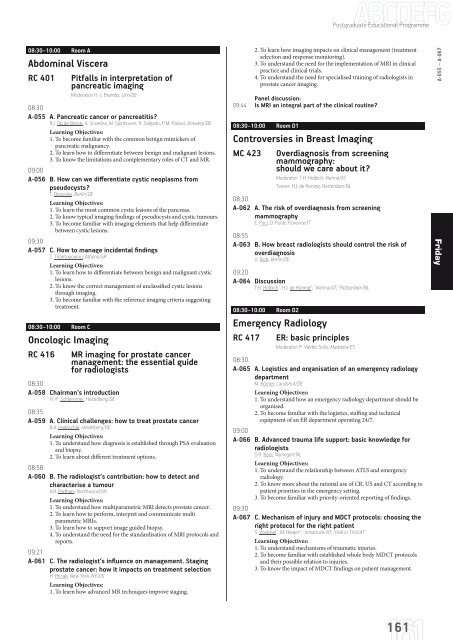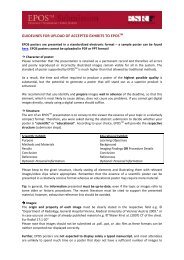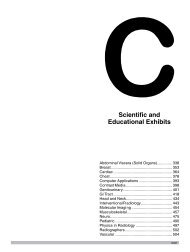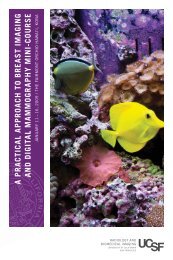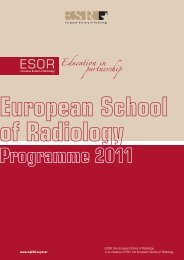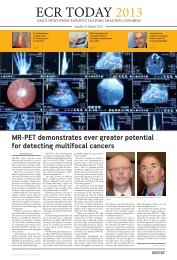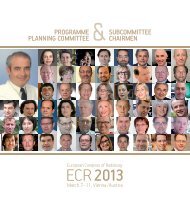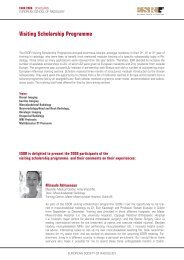ECR 2013 â Final Programme - myESR.org
ECR 2013 â Final Programme - myESR.org
ECR 2013 â Final Programme - myESR.org
- No tags were found...
You also want an ePaper? Increase the reach of your titles
YUMPU automatically turns print PDFs into web optimized ePapers that Google loves.
Postgraduate Educational <strong>Programme</strong>08:30–10:00 Room AAbdominal VisceraRC 401 Pitfalls in interpretation ofpancreatic imagingModerator: H.-J. Brambs; Ulm/DE08:30A-055 A. Pancreatic cancer or pancreatitis?B.J. Op de Beeck, A. Snoeckx, M. Spinhoven, R. Salgado, P.M. Parizel; Antwerp/BELearning Objectives:1. To become familiar with the common benign mimickers ofpancreatic malignancy.2. To learn how to differentiate between benign and malignant lesions.3. To know the limitations and complementary roles of CT and MR.09:00A-056 B. How can we differentiate cystic neoplasms frompseudocysts?T. Denecke; Berlin/DELearning Objectives:1. To learn the most common cystic lesions of the pancreas.2. To know typical imaging findings of pseudocysts and cystic tumours.3. To become familiar with imaging elements that help differentiatebetween cystic lesions.09:30A-057 C. How to manage incidental findingsC. Triantopoulou; Athens/GRLearning Objectives:1. To learn how to differentiate between benign and malignant cysticlesions.2. To know the correct management of unclassified cystic lesionsthrough imaging.3. To become familiar with the reference imaging criteria suggestingtreatment.08:30–10:00 Room COncologic ImagingRC 416 MR imaging for prostate cancermanagement: the essential guidefor radiologists08:30A-058 Chairman‘s introductionH.-P. Schlemmer; Heidelberg/DE08:35A-059 A. Clinical challenges: how to treat prostate cancerB.A. Hadaschik; Heidelberg/DELearning Objectives:1. To understand how diagnosis is established through PSA evaluationand biopsy.2. To learn about different treatment options.08:58A-060 B. The radiologist‘s contribution: how to detect andcharacterise a tumourA.R. Padhani; Northwood/UKLearning Objectives:1. To understand how multiparametric MRI detects prostate cancer.2. To learn how to perform, interpret and communicate multiparametric MRIs.3. To learn how to support image guided biopsy.4. To understand the need for the standardisation of MRI protocols andreports.09:21A-061 C. The radiologist‘s influence on management. Stagingprostate cancer: how it impacts on treatment selectionH. Hricak; New York, NY/USLearning Objectives:1. To learn how advanced MR techniques improve staging.2. To learn how imaging impacts on clinical management (treatmentselection and response monitoring).3. To understand the need for the implementation of MRI in clinicalpractice and clinical trials.4. To understand the need for specialised training of radiologists inprostate cancer imaging.Panel discussion:09:44 Is MRI an integral part of the clinical routine?08:30–10:00 Room D1Controversies in Breast ImagingMC 423 Overdiagnosis from screeningmammography:should we care about it?Moderator: T.H. Helbich; Vienna/ATTeaser: H.J. de Koning; Rotterdam/NL08:30A-062 A. The risk of overdiagnosis from screeningmammographyE. Paci, D. Puliti; Florence/IT08:55A-063 B. How breast radiologists should control the risk ofoverdiagnosisU. Bick; Berlin/DE09:20A-064 DiscussionT.H. Helbich 1 , H.J. de Koning 2 ; 1 Vienna/AT, 2 Rotterdam/NL08:30–10:00 Room D2Emergency RadiologyRC 417 ER: basic principlesModerator: P. Valdés Solís; Marbella/ES08:30A-065 A. Logistics and <strong>org</strong>anisation of an emergency radiologydepartmentM. Körner; Landshut/DELearning Objectives:1. To understand how an emergency radiology department should be<strong>org</strong>anised.2. To become familiar with the logistics, staffing and technicalequipment of an ER department operating 24/7.09:00A-066 B. Advanced trauma life support: basic knowledge forradiologistsD.R. Kool; Nijmegen/NLLearning Objectives:1. To understand the relationship between ATLS and emergencyradiology.2. To know more about the rational use of CR, US and CT according topatient priorities in the emergency setting.3. To become familiar with priority-oriented reporting of findings.09:30A-067 C. Mechanism of injury and MDCT protocols: choosing theright protocol for the right patientS. Voelckel 1 , M. Rieger 2 ; 1 Innsbruck/AT, 2 Hall in Tirol/ATLearning Objectives:1. To understand mechanisms of traumatic injuries.2. To become familiar with established whole body MDCT protocolsand their possible relation to injuries.3. To know the impact of MDCT findings on patient management.A-055 – A-067Friday161


